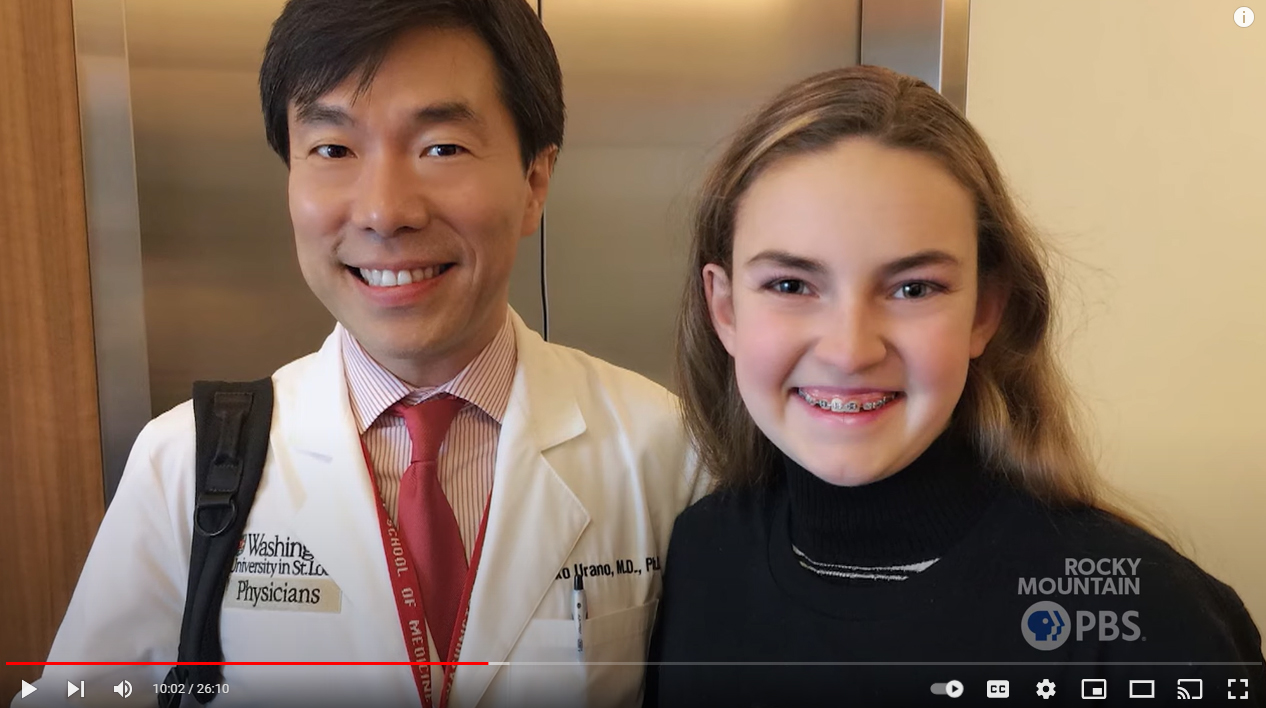Translational Science Benefits
Summary
This is the second case study published on Dr. Urano’s work on Wolfram Syndrome. See the 2018 New Therapies for Wolfram Syndrome to learn about Dr. Urano’s earlier work.
Wolfram Syndrome (WS) is a rare inherited condition characterized by juvenile-onset diabetes, vision loss, deafness, and neurodegeneration. In the majority of cases, these symptoms are attributed to pathogenic changes affecting the WFS1 gene. In rare cases, the CISD2 gene is involved.1 WS affects one in 500,000 people worldwide and is often fatal by mid-adulthood because of its impact on multiple organs.2 Recent research has shown that WS is a spectrum, meaning that the severity of the condition can vary from mild to severe based on the types of pathogenic changes in the WFS1 and CISD2 genes.3 This finding highlights the need for more genetic research to best understand the genotype-phenotype relationships in WS. This case study builds on previous work from Dr. Urano, whose last case study highlighted findings indicating endoplasmic reticulum (ER) dysfunction plays a role in WS.
Because multiple pathogenic changes in the WFS1 gene cause WS, the best chances at discovering a cure are through multiple approaches. Dr. Urano has continued his previous work with rodent and cell models of WS to study molecular pathways altered, like cell signals, in WS.4 He has played a crucial role in establishing the Washington University International Registry and Clinical Study for Wolfram Syndrome, aimed at gathering biological specimens for biomarker identification, molecular insights, and natural history data from patients with WS. This registry and the associated clinical studies have provided valuable insights into the genetic information, natural course of the disease, and its associated comorbidities. These insights have benefitted not only Dr. Urano but also fellow researchers studying this rare disorder. Dr. Urano has worked on multiple rodent and cell models that mimic WS in humans to study the progression of the disorder. Once these models are established, he can introduce potential treatments to study their effects. Building upon his previous research on ER dysfunction, Dr. Urano has conducted pre-clinical studies that provide the groundwork for a clinical trial of drug AMX0035. This clinical trial is in Phase II, meaning the drug is being investigated for its efficacy and safety in patients.
Finally, in 2020 Dr. Urano opened the Wolfram Syndrome and Related Disorders Clinic, serving WS patients and their families.5 This clinic offers evaluation for suspected WS cases, education about WS, and counseling for those affected by WS. Patients can consult with a variety of specialists, including neurologists, neuro-ophthalmologists, urologists, and others to develop patient-specific care management plans. Dr. Urano spoke about this clinic and his work when he was interviewed on the “It Happened To Me” Podcast in December 2023. He also contributed to a PBS documentary on Wolfram Syndrome.

Rocky Mountain PBS documentary
on Wolfram Syndrome
Significance
Dr. Urano’s translational research efforts using bench and clinical methods has led to new insight to better understand WS. Additional work with WS patient samples may produce a better understanding of genetic causes of WS, potentially leading to new diagnostic and therapeutic tools. By working directly with WS patients through the Washington University International Registry and Clinical Study for Wolfram Syndrome, researchers have access to a pool of genetic information not previously available for this rare disorder. Findings from genetic data analysis could inform future diagnostic and therapeutic procedures.
Dr. Urano has also been involved in multiple models of WS. He has created robust rodent and induced pluripotent stem cell (iPSC) WS models and filed license agreements to allow other researchers to use these models for their research. Through his work with these models, Dr. Urano and other researchers observed improved glucose tolerance in the rodent model and improved beta cell function in the iPSC-derived beta cell model with the administration of dulaglutide, a GLP-1R agonist.6 These findings indicate dulaglutide as a potential treatment for WS.
Dr. Urano has received a patent for pancreatic beta cell dysfunction diagnosis, which is associated with ER stress in chronic disorders like WS.7,8 This work is a step toward future diagnostic and therapeutic procedures for WS. The drug AMX0035 has concluded a Stage II clinical trial. This drug addresses ER stress and will hopefully delay or stop WS progression. The new Wolfram Syndrome and Related Disorders Clinic improves access to care and provides information about WS, a rare disorder. The patient information received from the research clinic could lead to new diagnostic tests or treatments for WS.
Benefits
Demonstrated benefits are those that have been observed and are verifiable.
Potential benefits are those logically expected with moderate to high confidence.
Identified dulaglutide as a potential therapeutic for Wolfram Syndrome in mouse and iPSC models. demonstrated.
Clinical
Data analysis from the clinical registry may lead to new therapeutic procedures. potential.
Clinical
Data analysis from the clinical registry may lead to new diagnostic procedures. potential.
Clinical
Continued research to promote drug AMX0035, a drug that has completed a Phase II clinical trial.
demonstrated.
Clinical
Helped create a new clinic to offer evaluation, education, and counseling. demonstrated.
Community
Helped create a new clinic to offer evaluation, education, and counseling. demonstrated.
Community
Helped create a new clinic to offer evaluation, education, and counseling. demonstrated.
Community
Improved quality of life and life expectancy for patients with Wolfram Syndrome due to this body of work. potential.
Community
Dr. Urano and collaborator Dr. Kohsuke Kanekura received a patent for technology to diagnose pancreatic beta cell dysfunction. demonstrated.
Economic
Created license agreement for mouse model (tech ID T-019506). demonstrated.
Economic
Created license agreement for WS humanized rat model (tech ID T-019403). demonstrated.
Economic
Clinical
Dr. Urano’s continued work with WS patient biological samples may uncover relationships between genes and WS. This research can be supplemented with the new molecular information made possible by the new WS patient registry and clinical study. Patients at the clinic can donate biological samples, such as blood, to be used in WS research like biomarker identification and genotype-phenotype relationships. This important contribution allows Dr. Urano and other Washington University researchers to analyze genetic mutations and biomarkers in actual WS patients, with the goal of developing new WS therapies and diagnostic tests. Other research through rodent and iPSC models found that dulaglutide, a GLP-1R agonist, was linked to reversed impaired glucose intolerance.6 When dulaglutide was added to iPSC-derived beta cells taken from WS patients, beta cell function improved. The effects of dulaglutide across multiple models indicate that dulaglutide could be a potential treatment for WS patients. Current treatments for WS include a clinical trial for drug AMX0035.9 This clinical trial is in Phase II. The first patient in this trial received treatment in April 2023, and there are an estimated 12 participants enrolled as of January 2024.9,10 AMX0035 has been developed in conjunction with Amylyx Pharmaceuticals. These ongoing research projects may lead to breakthrough for treatment of WS and other common diseases such as diabetes, neurodegeneration and blindness.
Community
Most notably, Dr. Urano has created a new clinic with the goal of providing genetic evaluations, education, counseling, and a personalized management plan for Wolfram Syndrome patients and their family members. These services are also offered to people with suspected Wolfram Syndrome. Patients can receive individualized treatments with the collaboration of a variety of specialists, including neurologists, neuro-ophthalmologists, urologists, medical geneticists, and endocrinologists. The clinic offers new health services for the community, increased accessibility to health care, and improves delivery of health services for people with Wolfram Syndrome. As of January 2024, the clinical study had received medical records from 300 patients, biological samples from 100 patients, and engaged more than 50 patients in a longitudinal study.
Economic
Dr. Urano has created multiple models to study Wolfram Syndrome, including recombinant DNA, mouse, rat, and iPSC models. Models are used in research to study how diseases progress because their lifespans are much shorter than humans. This work has resulted in many license agreements for biological materials. These models include a knock-out mouse model (tech ID T-019506), and a humanized rat model (tech ID T-019403).11,12 Dr. Urano, alongside collaborator Dr. Kohsuke Kanekura, has also received a patent for technology to diagnose pancreatic beta cell dysfunction.8
Team Science Acknowledgement:
We thank all the members of the Washington University Wolfram Syndrome Study and Research Clinic for their support (https://wolframsyndrome.wustl.edu) and all the participants in the Wolfram syndrome International Registry and Clinical Study, Research Clinic, and Clinical Trials for their time and efforts.13
- Rigoli L, Caruso V, Salzano G, Lombardo F. Wolfram Syndrome 1: From Genetics to Therapy. Int J Environ Res Public Health. 2022;19(6):3225.
- Urano F. Wolfram Syndrome: Diagnosis, Management, and Treatment. Curr Diab Rep. 2016;16(1):6.
- De Franco E, Flanagan SE, Yagi T, et al. Dominant ER Stress–Inducing WFS1 Mutations Underlie a Genetic Syndrome of Neonatal/Infancy-Onset Diabetes, Congenital Sensorineural Deafness, and Congenital Cataracts. Diabetes. 2017;66(7):2044-2053.
- Kitamura RA, Maxwell KG, Ye W, et al. Multidimensional analysis and therapeutic development using patient iPSC–derived disease models of Wolfram syndrome. JCI Insight. 2022;7(18).
- Dr. Fumihiko Urano Archives – Page 2 of 8. The Snow Foundation. Published September 29, 2020. Accessed December 19, 2023.
- Gorgogietas V, Rajaei B, Heeyoung C, et al. GLP-1R agonists demonstrate potential to treat Wolfram syndrome in human preclinical models. Diabetologia. 2023;66(7):1306-1321.
- Mahadevan J, Morikawa S, Yagi T, et al. A soluble endoplasmic reticulum factor as regenerative therapy for Wolfram syndrome. Lab Invest. 2020;100(9):1197-1207.
- Urano F, Kanekura K. Soluble MANF in pancreatic beta-cell disorders. Published online February 12, 2018. Accessed November 28, 2023.
- Amylyx Pharmaceuticals Inc. A Phase II Study of Safety and Efficacy of AMX0035 in Adult Patients With Wolfram Syndrome. clinicaltrials.gov; 2023. Accessed December 31, 2023.
- Dr. Fumihiko Urano Archives. The Snow Foundation. Published September 14, 2023. Accessed October 31, 2023.
- Wolfram syndrome conditional knock-out mice. Washington University in St. Louis. Accessed December 19, 2023.
- Humanized rat model of Wolfram Syndrome. Washington University in St. Louis. Accessed December 19, 2023.
- Lee EM, Verma M, Palaniappan N, et al. Genotype and clinical characteristics of patients with Wolfram syndrome and WFS1-related disorders. Frontiers in Genetics. 2023;14. Accessed December 19, 2023.

